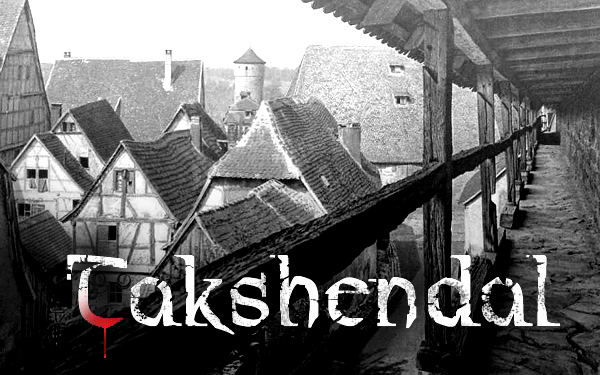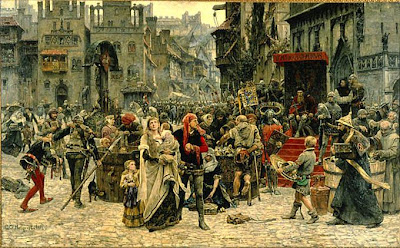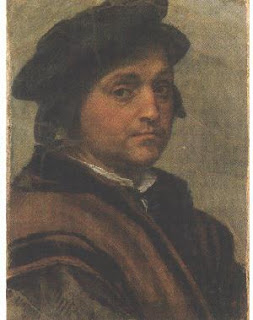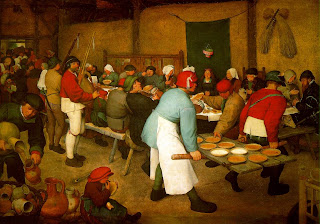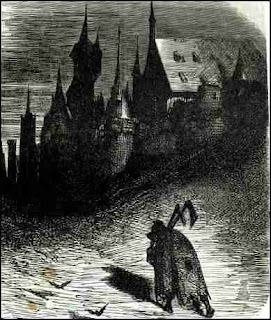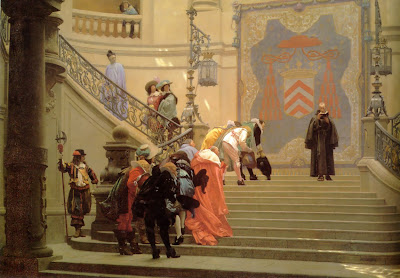
Several days after the rebellion against the Grand Arch Duke had been thwarted, Adriana Arabella Wormpole, apparently acting on her own volition, but with some help from within the City Militia, asked Misteline to go with Captain Silas to find the Black Rock, and if possible, render it harmless. It was understood that the Black Stone came from the isolated village of Slapershaven, high up the River Verdu on the southern bank of Lake Slapersmeer, in a desolate frontier region where winters were hard and the land harder yet. It was also hinted that the city might not be all that safe for Misteline and his friends in the light of recent events, but in any case, Misteline took on the task and set off with Drake, Rufus and Silas. The journey to Slapershaven took three weeks, and the last leg was aboard the river trade ship Stella of Albinius Moonshank and his son Lukas.
Slapershaven it transpired was the last navigable settlement on the river and a local trade centre for the frontier farmers. The headsman of Slapershaven was called Herluf Brethouwer and he was the richest man in the region. Herluf was hospitable and helpful and gave the group lodging in his home.
Misteline and his companions quickly learned that Slapershaven was cursed by a local bogeyman named Clod who apparently stalked the village at night. Already their first night in the village, the characters came into contact with this creature when they heard it splashing about in the lake. Although it was the middle of the night they rushed out to investigate and managed to scare the creature away, but after they had returned to the headman’s house, Clod returned, and under mysterious circumstances, apparently made off with the trader Albinius Moonshank. This prompted a fruitless search for the body on the morrow.
The villagers seemed strangely despondent with regards to Clod and after a half day or so; the village appeared to return to some semblance of normality. Misteline began investigating the locals and quickly identified a local lunatic Samuel Leadfern as suspicious. This man, who had once been the inn keeper of ‘Ye Merry Badger’, was locked in his room above the tap room where his hoarse screaming could clearly be heard. Despite this awful noise, the villagers seemed some what oblivious to the wretch. His daughter Juliana and her friend Molly Frith were left to run the inn and take care of him. Misteline had Drake make a healing concoction to ease the troubled mans mind and then with the daughter’s permission, interrogated Leadfern with regards to his madness. Piecing together the various rumours from the villagers with the scant information gained from this interview, Misteline was able to conclude that at some point in the past, Leadfern and his wife had been up in the mountains hunting fossils. Fossils are a source of extra income for the locals as good examples can fetch a high price amongst collectors in the outside world. During this trip, Leadfern and his wife brought back a Black Rock, roughly the size of three cabbages, whose physical description matched the Black Rock fragments. The couple owned this rock for some time before illness overtook Samuel Leadfern, and Clod then apparently abducted his wife. Leadfern it seemed then agreed to sell the Black Rock via the village shopkeeper, Bartlemy Linschoten.
Misteline knew some one in the village had sold the Black Rock to Bartholumus Pyle and wondering whether or not Linschoten was another agent of Renas Costa he decided to try and fool the shop keeper by forging a letter from Pyle asking for another such black rock and to pass this letter to Linschoten as if he were merely a messenger. Linschoten read the letter but apologised and explained that there had only ever been the one shard and that was all sold now. He appeared to be altogether ignorant of Bartholumus Pyle. He did however explain that the Black Rock had only been one shard of a much larger stone, and the rest of this curious rock was most likely still where Samuel Leadfern and his wife had found it. Misteline then arranged to travel up into the mountains and a local man named Jarolf Lowhouse agreed to guide them some of the way.
The next day under a glorious sky with a shining sun, the adventurers travelled up the road from Slapershaven, on their way to the mountains. With them went Lukas Moonshank who was intent on discovering what was going on and if possible, to avenge the assumed death of his father. By mid day the group reached the first camp site, where Silas was forced to have his feet dressed by Drake as his soft city foot wear had failed to protect his feet against the rocky land. As the group sat about a well stoked camp site, they had a splendid view of the Slapersmeer and could clearly see a twin masted caravel approaching Slapershaven. Since they knew that no traders except Albinius Moonshank ever came this far up the river, they concluded that the enemy was approaching. Leaving Drake to keep watch they pressed quickly onwards. Drake waited at the last vantage point and observed the village below with Misteline’s telescope. He saw very little, but enough to recognise several men in red bearing metal. Not long after these men left Slapershaven in the company of a man in blue and began to follow the road... Drake hurried to catch up with his friends.
The party, now minus Jarolf who had taken a different road to his brothers property, regrouped at a tenant farm belonging to Herluf Brethouwer where three farm hands were pleased to give them shelter. Misteline was worried that the people following them might be able to catch them up during the night however so he advocated sleeping in the forest. This was a prudent, but unfortunate decision for the rain began and the next morning saw a distant pillar of smoke indicating that the other party had camped at the first camp site rather than press on.
Some what gloomily Misteline and his companions made their way through the woods to the last farm before the mountains. This small homestead was owned by Verity Hacker and in the pouring rain; this good woman took the bedraggled friends in and gave them a hot meal. Misteline told Verity of their pursuers and urged caution, but Verity seemed unafraid. She sent the friends on their way and gave them wet weather clothing. She knew of the black stone, even to the point of referring to it as the ‘famous black stone’ and guessing it was a ‘stone from the sky. She was happy to give directions to the Dark Pools, where the rock rested. Misteline and his friends set off up into the mist soaked valley, but once again Drake remained to keep watch.
Finding the Dark Pools was not too difficult, though getting their in the wet, cold and miserable landscape was. The rain turned the ground into a slippery quagmire filled with boulders and as they travelled by the swollen river, the group had to negotiate numerous fallen trees, landslides and a lot of savage undergrowth. Finally they reached the tributary river along whose length they came to the Dark Pools. Here tall cliffs meant they could go no further, but this made no difference for in the dim twilight they finally found the Black Rock!

The Black Rock was lying by itself to one side of the upper pool. It was large and obviously too heavy to move. Misteline reckoned it probably weighed over a ton at least. On one side it had a flat facet where it had split at some point in the past. There was only the one rock which was pitted and pock marked, black and slightly metallic in appearance. Misteline’s knowledge was unable to guess at what kind of a rock it was, but he agreed with Verity Hacker in guessing it was a ‘stone from the sky’.
In the meantime, Drake waited in the rain for as long as he could but when the darkness gathered he decided he’d waited long enough. Just as he was beginning to leave however, he heard voices and saw several armoured soldiers bearing pikes and red cloaks escorting a man in a blue cloak to the farm of Verity Hacker. He counted six soldiers in all, then quickly made his way up the river. The going was tough, but Drake was cautious and experienced and he managed to avoid falling into the river. After an hour or so he suddenly came across two men coming in the opposite direction, and after hiding to observe them, he introduced himself to the notorious Groot Brothers.
Adolphus and Bertholdt Groot were two local outlaws who had been living off the land for years after fleeing from a murder. Drake had heard of them from the villagers and from Verity Hacker, and understood that the Brothers were heading for Verity Hackers farm where they were accustomed to a welcome it seemed. The Brothers were suspicious of Drake, but they were cold, wet and miserable and they didn’t fancy picking a fight with a stranger in the dark, especially not after they learned of the pike men who were at Verity Hackers farm. They hurried on their way and Drake pressed on.
Misteline, Silas, Lukas and Rufus had made a shelter of sorts below some pine trees, and were trying to get some sleep when Drake finally caught up with them. Learning of the six pike men the group decided to set a guard and get as much rest as possible. Misteline was all for setting a dawn ambush, but Drake and the others were too tired to care much. After two days in the rain and filth, the others were exhausted, wet and despondent. Not long after the group had fallen asleep, the Groot brothers, sent by Verity Hacker, turned up to warn that the Pikemen were after them. The brothers agreed to stay and help Misteline and his companions, if they would take the brothers away from the area. Both brothers were emaciated, had bad teeth and were sick of living by themselves.
After a tiresome night with precious little sleep Misteline was awoken to the news that the Pikemen had anticipated an ambush and had them selves set out before dawn to catch the group unawares. There were only a few minutes to take up defensive positions, but every one rallied and when the pike men arrived they found the way blocked. The man in blue stepped forth and began to talk.
His name it transpired was Archibald Pillorseed and it seemed he was indeed an agent of Renas Costa, though he never actually said this himself. He gave Misteline to understand that he was under orders not to kill Misteline, but that unless Misteline gave up the Black Rock, he would order his men to kill Misteline’s companions. Pillorseed did not seem aware of the size of the Black Rock. Misteline rejected Pillorseed’s ultimatum and so the two sides drew apart. Misteline hid amongst the pine tree’s and rocks to the north of the dark pools, but Pillorseed sent three of his men around the southern bank whilst he and the other three guarded the stream, effectively trapping the companions and preventing them from escaping to make ambushes later on. As the three pike men advanced, supported by Silas with his crossbow, Drake opened fire with his long bow and killed two of them outright. The third retreated to where Pillorseed and the remaining pike men held the stream. A stand off was in the offing, but now Rufus and Lukas attempted to taunt the enemy into a brazen attack. Approaching the pike men Rufus miscalculated their reach and was quickly stabbed multiple times and unable to resist. Misteline rushed forwards to help but it was to no avail. Rufus was helpless and a hostage.
Once more Pillorseed spoke. He offered to allow Misteline to go in peace, provided Misteline swore not to try any ambushes on the way back to the village. Knowing that the weight of the Black Rock gave him an advantage, Misteline accepted. Pillorseed silenced his grumbling men and released the sheepish Rufus. Soaked to the bone, miserable and with Rufus in the first stages of a fever, the group made their way back to Slapershaven where they found Archibald Pillorseed’s chartered ship, a Skavian vessel, moored along side Lukas’s trader. Misteline proposed a joint attack on the ship but Herluf Brethouwer refused to get involved.
Things looked dire until Silas bought off the Skavian crew who then quickly captured the two marines Pillorseed had left as a guard. Lukas set sail and Silas bought all the fishing boats in the village. Knowing that the winter would effectively block the river until February, and together with the removal of the fishing boats, Misteline proposed to trap Pillorseed in Slapershaven until such time as the authorities in Takshendal could send soldiers to arrest him.
The job done, Misteline and his companions (including the Groot brothers) returned to Takshendal where they each went their separate ways again.
The next year a small militia detachment rowed up the river to arrest Archibald Pillorseed, but they found no sign of him in Slapershaven. The villagers had not seen him return nor had Verity Hacker. The Black Rock was still lying beside the Dark Pools but it had been worked upon and parts had been broken off and carried away. The official conclusion was that either Archibald Pillorseed and his men had gotten lost or that they must have travelled back to Takshendal by the over land route. The militia guards then buried the remaining rock in an undisclosed location.
Some few weeks after he returned Silas found the promotion he had hoped for was given to another man. He hung about in Takshendal, waiting for orders and to pass the time he sometimes visited Misteline in his studio. On one such occasion he was able to tell Misteline that the man charged with keeping the Black Rocks had gone mad and the various shards had been locked away in a secret vault.
Months later Silas was finally promoted to the office of the Lord High Sheriff of the Marne Territories...

Misteline never did manage to solve the curse of Slapershaven, though he concluded from the available evidence that Clod was in fact Samuel Leadfern’s wife, driven mad by the Black Rock. When he mentioned this theory to Herluf Brethouwer, the headsman seemed strangely indifferent and Misteline concluded that every one in the village already knew who Clod really was.
